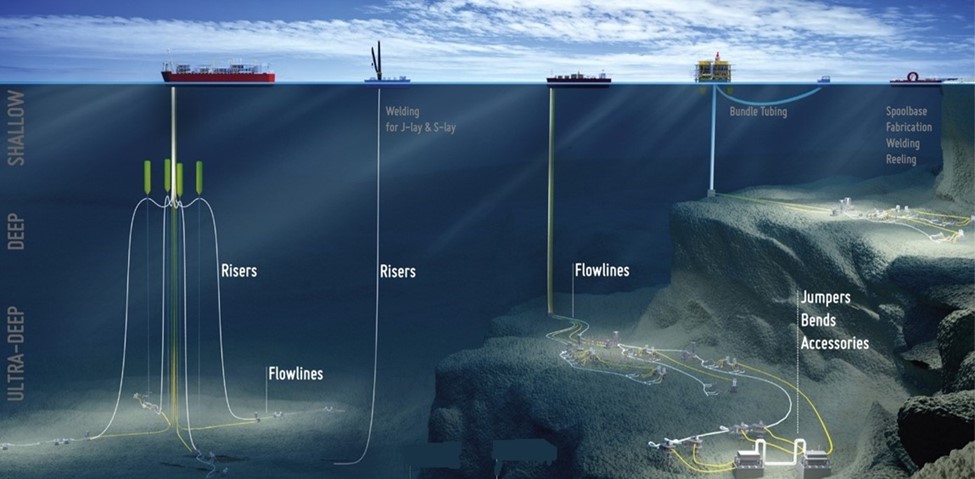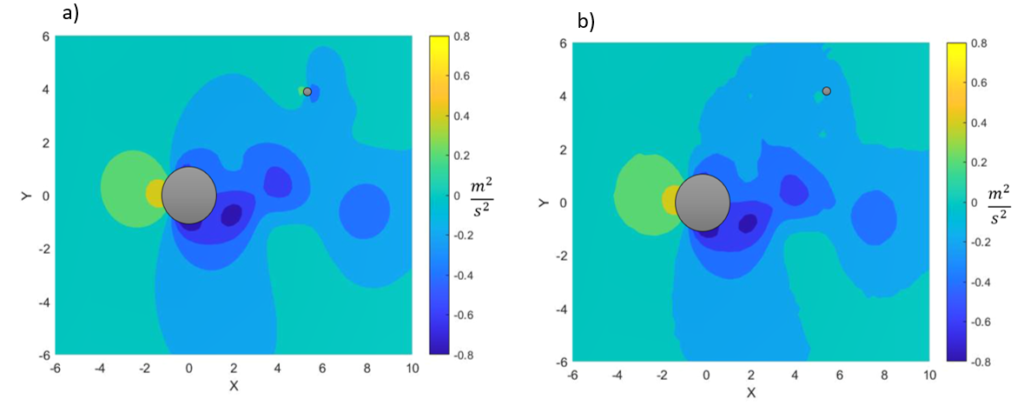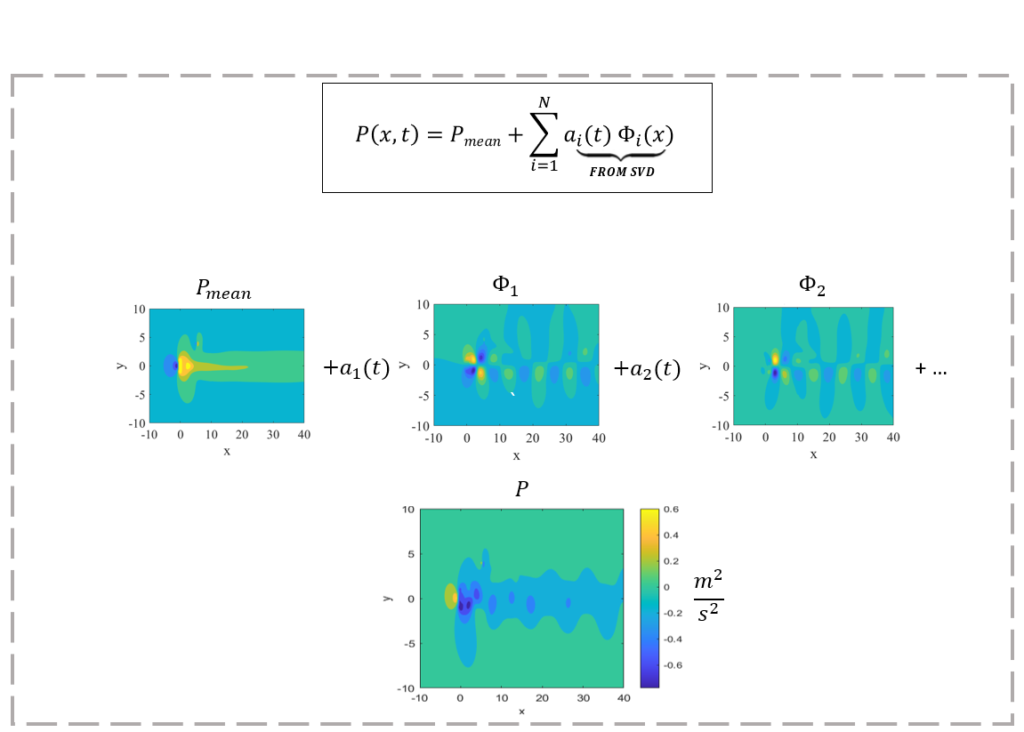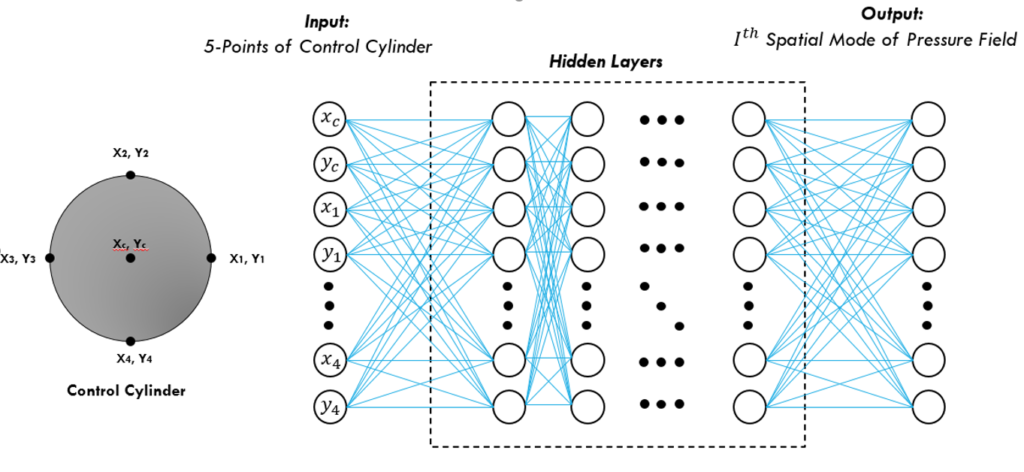Project Category: Mechanical
Join our presentation
About our project
Structures such as offshore risers, pipelines, and buildings are designed to operate while submerged in a fluid. These structures mechanically interact with the fluid that surrounds them and can create unwanted flow patterns. Von Kármán vortex shedding is one well-known flow pattern that can be created when a fluid interacts with a bluff body. A bluff body is a body that causes flow separation over a substantial part of its surface due to its shape. The Kármán vortices create unwanted fluctuating loads on the bodies. This could damage the structure or cause structural instability problems. The motivation of this project is to find a way to attenuate the effect that this phenomenon has on the structures. This is done by introducing a second much smaller bluff body in the wake of the main structure.

The main challenge associated with utilizing this mechanism of flow control is finding the location of the second body. Finding the appropriate position of the second body is not a trivial task. Misplacement of the second body could actually amplify the load fluctuations experienced by the main body or not affect the load fluctuations on the main body at all. The non-linear behavior of the flow field around the main body makes this seemingly simple control problem escalate to a problem that required data-driven methods of analysis and knowledge from multiple fields such as fluid mechanics, data science, and numerical simulations.
Our design consists of a multi-step algorithm that uses simplified models of a flow to attempt to find the optimal location for the second body. To collect training data a set of CFD simulations is created. The data obtained from the CFD simulations are then processed using mathematical tools to create simpler yet accurate flow models. Finally, these simpler models (low order models) are used to train a neural network. If successful, the results and methodology employed in this project could be used to improve the structural stability and longevity of many engineering structures and control undesired flow patterns in their wake.
Meet our team members



Details about our design
WHAT ARE THE APPLICATIONS OF THIS DESIGN
It is fascinating how many applications this methodology could have. This methodology could be used to design controls to attenuate the effect of undesired flow patterns on the wake of many engineering structures, enhancing their structural stability and promoting a longer lifecycle. A few examples of such structures are offshore risers and pipelines, as the ones illustrated in the picture below:

Another potential application is urban design. As cities are immersed in air, introducing a building such as the Calgary tower to an urban environment can significantly affect the local flow of air and influence pedestrian comfort. Thus, an algorithm that can predict the effect of introducing new buildings to a city on the local flow of air would be of great value.

WHAT MAKES OUR DESIGN INNOVATIVE
The idea of discovering models of dynamical systems purely from data is relatively new and has gained momentum in recent years. The design developed by our team uses Proper Orthogonal Decomposition (POD) to describe a physical system in terms of a finite (and small) number of dominant coherent patterns. This simplified description of the flow is integrated with neural networks to attempt to solve an optimization problem in fluid mechanics. This approach has not been used before to solve a problem of this nature, making our endeavor both innovative and challenging.

HOW WE VALIDATED OUR DESIGN SOLUTION
In order to validate the design as a whole first, we had to validate the CFD simulations. The first simulation having only the main cylinder (Re =150) was validated through two different methods. The first method of validation consisted of comparing the mean drag coefficient Cd obtained in the simulation to literature. The second method used to validate this simulation was to compare the Strouhal Number (St) of the simulation to its expected value found in the literature. After validating the single-cylinder CFD simulation, we constructed a two-cylinder simulation with a second cylinder having 1/8 of the diameter of the main cylinder and positioned on the wake of the main cylinder. To validate this double cylinder simulation, the Strouhal number, mean drag coefficient and mean lift coefficient were compared to the literature. After validation, there were a total of 11 simulations constructed with control cylinder at different positions. Some of the positions were chosen on the shear layer of the main cylinder, as literature indicated that this region is an influential region for controlling the flow dynamics of this setup.
The simplified models of the flow for the 11 CFD simulations had both a spatial and a temporal component, which was predicted independently by a set of neural networks from the control cylinder position as their input. The performance of neural networks responsible for predicting the spatial component of the decompositions was evaluated based on the avg L2-norm of the predicted positions and how well the predictions preserved the large-scale patterns of the actual spatial components. The performance of the neural networks responsible for predicting the temporal components of the decompositions was evaluated based solely on the numerical accuracy of the predictions of each temporal coefficient. The main difficulty arose when attempting to predict the frequency and the phase angle of the temporal coefficients. The frequency changes between positions were very small due to the ratio of the diameter of the two cylinders, so obtaining accurate predictions was difficult. The phase angles probably would require some form of time-varying input to be predicted and could not be determined accurately.
The hybrid predictions using the predicted spatial components of new positions and their true temporal components displayed relatively good accuracy, as can be seen in the video comparing the two in our gallery. If further investigation of the problem allows for the temporal component of the decomposition to be predicted, the method could be employed to solve the optimization problem on a given region of the flow.
HOW WELL DID THE DESIGN PERFORM
The neural networks are trained with mathematical models of the flow that decouple temporal and spatial variation (Proper Orthogonal Decomposition), and they are capable of predicting the spatial component of the decomposition for the test positions relatively well, but they had difficulties predicting the temporal component. The results obtained in this project were promising, and you can check our video demonstrating how well the neural networks were capable of predicting the kinematic pressure field around the main cylinder using the truly predicted spatial components with the actual temporal components of a test position. In the video, the predicted pressure field is shown at every instant in time, but here a single instant in time is shown.

One way of measuring the intensity of the load fluctuations on the main cylinder is using the root mean square of the lift coefficient of the main cylinder (Cl,rms). As the lift coefficient depends primarily on pressure, it could be calculated from the pressure distribution around the main cylinder for every instant in time. The quality of the predicted Cl,rms for each small cylinder position varied depending on the test position, and for the one shown above, the actual and predicted values of Cl,rms differed by approximately 5%. Most of the error was concentrated around the small cylinder, which is not a major issue, as the primary interest is the main cylinder. This can be observed from the contour plot of the error in the hybrid prediction below.

If you are interested in more details or if you would like to ask us questions, feel free to join us at our zoom meeting by clicking the button at the top of the page.
FEASIBILITY OF OUR DESIGN SOLUTION
Since this method was a novel approach to problem at hand, the problem was then simplified by few assumptions. The simulations were constructed for a laminar flow regime (Re = 150), and the flow was assumed to be two dimensional.
This is a novel approach, therefore there is room for improvement. First and foremost, if neural networks can be constructed for a temporal component of the low order models, then the combination of spatial and temporal neural networks can be used to test for any new control cylinder position in the domain surrounding the main cylinder. That would allow for calculation of rms lift to determine the optimal placement of the control cylinder with the lowest rms lift.
This methodology can then be extended beyond 2D and laminar flow to more realistic scenarios. And that makes this approach a promising method, as it would allow development of dynamic controllers to constantly move second bluff body around the main bluff body to an optimal position should the conditions of the flow change.
A LOOK INTO THE FUTURE
Problems in fluid mechanics are notoriously difficult, and that is partly because creating an accurate description of a system that evolves in time with non-linear dynamics is difficult. However, if the behavior of a complex physical system can be described in terms of a small number of dominant coherent patterns and how these patterns evolve in time, a much simpler framework for analysis becomes available. Pairing these models with machine learning algorithms makes for a powerful combination to approach unsolved problems involving the behavior of dynamical systems.
Partners and mentors
This work would not have been possible without the incentive and contributions made by our project sponsors, Dr. Paul Ziadé and Dr. Christopher Morton, from the Department of Mechanical and Manufacturing Engineering at the University of Calgary. The team would like to express its appreciation for the quality of the instruction and constructive feedback provided throughout the semester in our weekly meetings. We thank you for offering us the opportunity to work with a project within the field of interest of the group and closely supporting our work.
Our photo gallery



